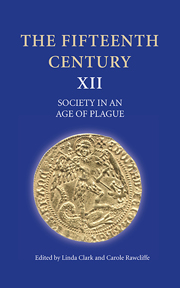Book contents
- Frontmatter
- Contents
- List of Illustrations
- Contributors
- Preface
- Abbreviations
- Introduction
- Looking for Yersinia Pestis: Scientists, Historians and the Black Death
- Pestilence and Poetry: John Lydgate's Danse Macabre
- Pilgrimage in ‘an Age of Plague’: Seeking Canterbury's ‘hooly blisful martir’ in 1420 and 1470
- An Urban Environment: Norwich in the Fifteenth Century
- Mid-Level Officials in Fifteenth-Century Norwich
- Leprosy and Public Health in Late Medieval Rouen
- Plague Ordinances and the Management of Infectious Diseases in Northern French Towns, c.1450–c.1560
- The Renaissance Invention of Quarantine
- Coping with Epidemics in Renaissance Italy: Plague and the Great Pox
- The Historian and the Laboratory: The Black Death Disease
- Index
- CONTENTS OF PREVIOUS VOLUMES
Pilgrimage in ‘an Age of Plague’: Seeking Canterbury's ‘hooly blisful martir’ in 1420 and 1470
Published online by Cambridge University Press: 05 September 2013
- Frontmatter
- Contents
- List of Illustrations
- Contributors
- Preface
- Abbreviations
- Introduction
- Looking for Yersinia Pestis: Scientists, Historians and the Black Death
- Pestilence and Poetry: John Lydgate's Danse Macabre
- Pilgrimage in ‘an Age of Plague’: Seeking Canterbury's ‘hooly blisful martir’ in 1420 and 1470
- An Urban Environment: Norwich in the Fifteenth Century
- Mid-Level Officials in Fifteenth-Century Norwich
- Leprosy and Public Health in Late Medieval Rouen
- Plague Ordinances and the Management of Infectious Diseases in Northern French Towns, c.1450–c.1560
- The Renaissance Invention of Quarantine
- Coping with Epidemics in Renaissance Italy: Plague and the Great Pox
- The Historian and the Laboratory: The Black Death Disease
- Index
- CONTENTS OF PREVIOUS VOLUMES
Summary
As Carole Rawcliffe has reminded us, in medieval culture the close linkage between the Church and healing with respect to both body and soul was widely understood, and pilgrimage was a principal means of seeking such aid. Even though the greatest collections of miracle cures at English shrines belong to the high Middle Ages, miracles continued to be recorded in various ways until the shrines were destroyed in the sixteenth century. Pilgrimage, too, was recognised for its penitential value, the shrine of St. Thomas of Canterbury being one of the four major destinations; and, as well as encouraging personal initiatives, certain bishops seem particularly to have favoured its imposition. Nor was the potential for bodily and spiritual healing confined to the individual pilgrim, or for those on whose behalf s/he was acting, because processions (and pilgrimages) were at times staged by entire communities in order to seek collective relief from specific dangers and disasters. In these circumstances, the Church often sanctioned a variety of pious activities, including the bearing of relics, in an attempt to avert divine wrath or retribution, notwithstanding the belief that such events might have been sent by God to punish or test mankind.
The upsurge in income received at English shrines in the fourteenth century, and especially about the time of the Great Famine and in the aftermath of the Black Death, would seem to represent a significant increase in the number of pilgrims acting individually and collectively in response to these crises. The apparent desire by so many to go on pilgrimage might even suggest that there were widespread apocalyptic fears; and, although such fears may have abated somewhat for succeeding generations, the sense that they were justified evidently remained. This is not to imply that the fifteenth century should be seen in terms of Johan Huizinga’s Waning of the Middle Ages, but that an awareness of ‘last things’ was part of that century’s cultural capital, whether in terms of contemporary art, literature, drama, or piety, including pilgrimage.
- Type
- Chapter
- Information
- The Fifteenth Century XIISociety in an Age of Plague, pp. 57 - 78Publisher: Boydell & BrewerPrint publication year: 2013

